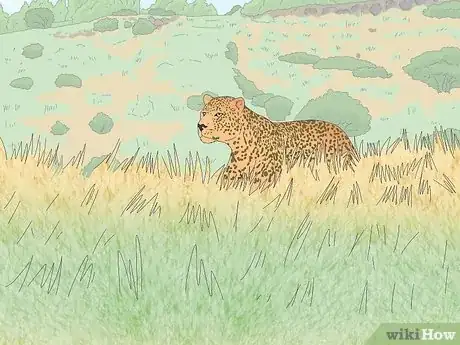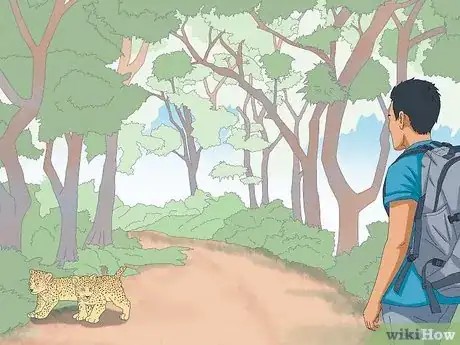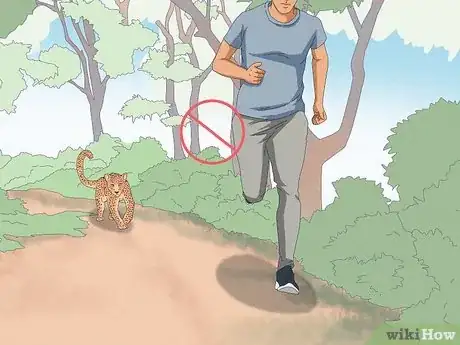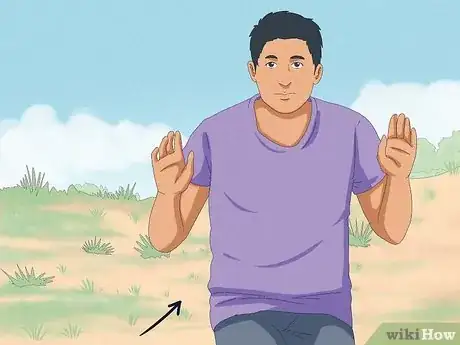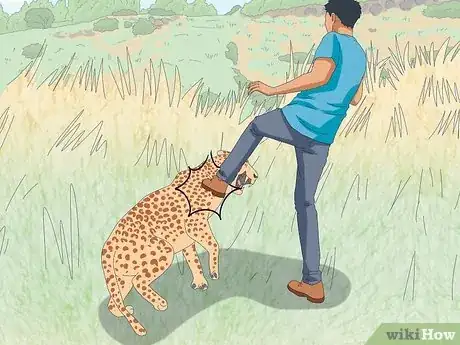X
wikiHow is a “wiki,” similar to Wikipedia, which means that many of our articles are co-written by multiple authors. To create this article, 18 people, some anonymous, worked to edit and improve it over time.
This article has been viewed 32,407 times.
Learn more...
Leopards are very powerful big cats, despite their small size. Though their range of territory is shrinking, they can still be found in many regions of Africa and southern Asia. These big cats are one of the least aggressive towards humans, compared to their larger relatives, but leopard attacks are not unheard of. If you're going to be entering possible leopard territory, it's a good idea to have a plan to keep yourself safe from potential danger.
Steps
Part 1
Part 1 of 2:
Preventing an Attack
-
1Understand how leopards hunt. Leopards typically avoid humans, but might risk hunting one if the human is small or appears small. Avoid crouching in leopard territory. Many leopard attacks on humans are because of the human crouching down and looking smaller than they actually are.[1] Children especially are at risk due to their small size, so keep them close and do not let children go outside alone at night.
- Leopards are very cautious hunters compared to their larger cousins in the big cat family. Leopards seek out small, easy prey and often won't take chances on attacking large creatures.
-
2Stay alert when traveling. Be very cautious if you are walking through leopard territory. Try to travel in groups and keep a very close eye on children. Leopards will typically avoid attacking if they feel outnumbered or disadvantaged.
- Avoid traveling at night. Leopards are mainly nocturnal hunters and as a result, are much more active at night. Stay at home or at camp during the nighttime.
Advertisement -
3Properly dispose of any trash. Though leopards themselves are not typically attracted food waste, other animals are. Trash left out can attract stray dogs or other small creatures which can attract the attention of leopards looking for prey. Properly dispose of any organic waste to avoid bringing leopards to your location.
-
4Leave leopard cubs alone. If you spot any leopard cubs in the area, leave immediately. Even if the mother is not around, she could return at any moment and may take your presence as a threat to her cubs. Leopard cubs are often stashed in the undergrowth of bushes or in trees when the mother is gone, so leave these be and do not go looking for cubs.[2]
-
5Don't draw attention to yourself. If you spot a leopard that doesn't appear to see you, do not disturb it. Leave slowly and quietly to avoid attracting unwanted attention. Sticking around and trying to get a closer look at the leopard could potentially make it feel threatened. Do not give a leopard any reasons to attack you.
-
6Do not provoke or corner a leopard. Leopards are shy and usually avoid humans, but have been known to attack if they feel threatened. If the leopard is cornered or surrounded by a crowd of humans, they might feel the only option is to fight back in order to escape.[3] Most leopards are not looking for a fight, so simply allow the cat to leave on it's own if you spot one.
Advertisement
Part 2
Part 2 of 2:
Surviving a Leopard Attack
-
1Do not run. This might feel like going against your instincts, but stand your ground and do not flee. Running away might just trigger the leopard to chase you down. The average top speed of a leopard is 35mph, so you won't have a chance of outrunning one.
- Climbing a tree to escape will not help. Leopards are excellent climbers and can scale a tree much faster than you can.
-
2Back away slowly. Instead of turning and running, continue to face the leopard and begin backing away slowly. Avoid eye contact, but keep the cat in view. If the leopard leaves you be, continue backing away until the leopard is out of sight. Then you can turn and quickly leave the area.
-
3Shout and wave your arms. If the leopard does not leave you alone or continues to approach, try to make yourself look threatening. Make loud noises by shouting, yelling or clapping your hands. Try to make yourself look bigger by waving your arms above your head and standing up straight. Do what you can to make yourself not look like an easy target.[4] Leopards are less likely to attack prey that looks large and threatening to them.
-
4Fight back if necessary. Fighting should be your last option. If the leopard does not stop charging, fight back however you can. Use weapons or other items to attack the leopard. Kick the chest or face. Punch sensitive areas on their head, like the eyes or nose. Dig your thumbs into their eye sockets if you can. Focus on protecting your neck, as that is where leopards bite to kill their prey.
- Your goal should be inflicting as much damage as you can to try and dissuade the leopard from continuing to attack. The leopard might flee if it feels you are not worth fighting. An injured leopard cannot hunt, so many leopards will avoid dangerous fights to keep themselves safe.
-
5Seek immediate medical attention if injured. Attempt to stop any major bleeding from deep gashes or other serious wounds if you can. Call for help and search for people nearby for assistance. Get medical attention as soon as possible, even for minor injuries, as the risk of infection can be higher in wounds caused by animals.
Advertisement
Warnings
- Never ever approach a wild leopard. You can get a view close to them through your lens.⧼thumbs_response⧽
- Avoid approaching leopard cubs. Mothers will be very protective.⧼thumbs_response⧽
- Be extra careful at nighttime. Leopards are nocturnal hunters and are much more active at night.⧼thumbs_response⧽
- Never climb a tree to escape from a leopard. These are probably the best wild cats at climbing trees and will catch you in a matter of seconds.⧼thumbs_response⧽
Advertisement
About This Article
Advertisement
